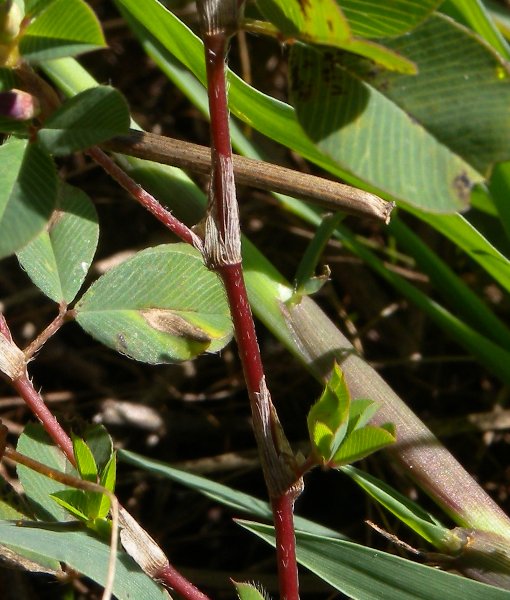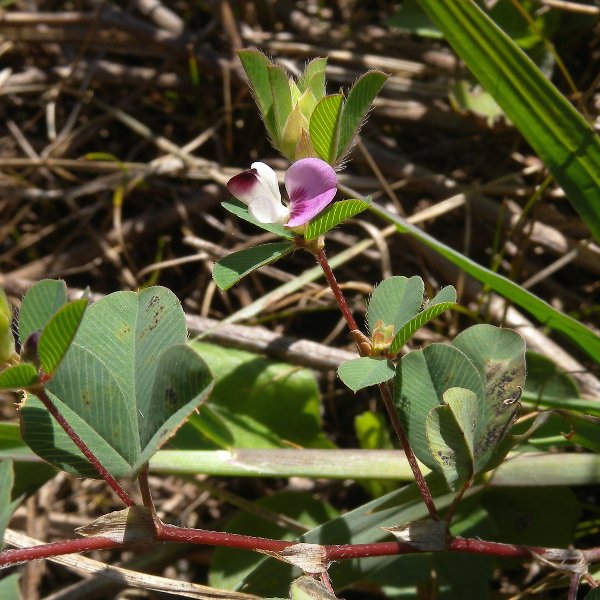Korean Bush Clover
Kummerowia stipulacea
Bean family (Fabaceae)
Kummerowia stipulacea
Bean family (Fabaceae)
Description:
This herbaceous plant is a summer annual, producing leafy stems from
4–18" (1–4.5 cm.) long. These leafy stems are either erect, ascending,
or sprawling, and they branch occasionally. Very young stems are light
green, otherwise they are reddish brown to brown; these stems are also
terete and they have scattered hairs that are somewhat appressed and
upward-pointing. Alternate trifoliate leaves occur at intervals along
the stems. The petioles of these leaves are somewhat short (4–10 mm.
long), terete, reddish brown to brown; they also have scattered
upward-pointing hairs like the stems. Individual leaflets are 6–20 mm.
long and 4–15 mm. across; they are usually obovate or oval in shape,
but sometimes broadly elliptic. The outer margins of these leaflets are
rounded, obtusely pointed, or even slightly indented in the middle; the
narrow midveins of these leaflets are slightly exserted. The margins of
the leaflets are also conspicuously ciliate, especially when they are
young. These leaflets are nearly sessile where they connect with the
outer tip of each petiole. The upper
leaflet surface grayish green to green and hairless (or nearly so),
while the lower leaflet surface is pale green and sparsely covered with
short appressed hairs; the underside of the midveins, however,
typically has more abundant longer hairs.

At the base of each petiole, there is a pair of lanceolate stipules about 3–8 mm. long. These relatively large stipules become stramineous (straw-colored) to brown with age; they are also glabrous with conspicuous veins. From the axils of the middle to upper leaves, 1–2 small flowers develop that are about ¼" long or slightly longer (6–7 mm. in length). These flowers have a typical pea-shaped floral structure, consisting of an upright standard and a pair of wings that straddle each side of a forward-pointing keel. The standard is mostly rosy pink with radiating bars of magenta (purplish red) at its base. The narrow lateral wings are white, while the central keel is white with a dark magenta tip. The keel is longer than the wings, becoming more vertically broad at its tip; the keel is about the same length as standard. At the base of each flower, there is a short-tubular calyx with ovate or broadly oblong lobes; this calyx is about 3 mm. long, light green, and mostly hairless. This plant occasionally produces inconspicuous cleistogamous flowers that lack petals. The blooming period occurs from mid-summer to mid-autumn, lasting about 2–3 months. Individual flowers are replaced by short, single-seeded pods that are laterally compressed; mature seedpods are slightly longer than the calyces. The mature seeds of this plant are about 2 mm. long, dark brown to black, shiny, and compressed-ovoid in shape. The root system has a narrow branching taproot that sometimes forms swellings from rhizobial bacteria. This plant reproduces by reseeding itself.

Cultivation: The preference is full sun, mesic to dry-mesic conditions, and a somewhat barren soil containing clay, rocky material, gravel, or sand. A pH of 6–7 is acceptable. Most growth and development occurs during the summer. This plant can become somewhat invasive at some locations.
Range & Habitat: Korean Bush Clover (Kummerowia stipulacea) is occasional to fairly common in southern and central Illinois, but it is more scattered and less common in northern Illinois (see Distribution Map). This non-native plant was introduced from east Asia for agricultural purposes. It is widely distributed in the eastern half of the United States. Habitats include dry open areas of prairies, sandstone glades, roadsides, areas near parking lots, areas along railroads, fallow fields, and waste areas. This plant is sometimes grown as a cover crop and for forage. Open, sunny habitats with a history of disturbance are preferred.

Faunal Associations: The flowers are probably cross-pollinated primarily by Halictid bees and other small bees. The adults of a leaf beetle, the Grape Colaspis (Colaspis brunnea), feed on the leaflets of Korean Bush Clover (Kummerowia stipulacea), while the larvae of this beetle sometimes feed on the roots (Clark et al, 2004). Probably many of the insects that feed on bush clovers (Lespedeza spp.) also feed destructively on this plant. The seeds of Korean Bush Clover and other Oriental bush clovers (Kummerowia spp.) are eaten by some birds, including the Mourning Dove, Wild Turkey, and Greater Prairie Chicken, while the Canada Goose feeds on the foliage (Lewis, 1993; Martin et al., 1951/1961; Korschgen, 1962; Bellrose, 1942/1976). The foliage of these plants is also palatable to White-tailed Deer, Elk, cattle, sheep, and other domesticated livestock (Sotala & Kirkpatrick, 1973; Schneider et al., 2006).
Photographic Location: At the base of an open slope near the parking lot at the Sangamon River Forest Preserve in Champaign County, Illinois.

Comments: This plant can be overlooked because of its small size, but it is rather ornamental when it is viewed up-close. Korean Bush Clover (Kummerowia stipulacea) is very similar in appearance to Japanese Bush Clover (Kummerowia striata). Japanese Bush Clover differs from the former species by having leaflets that tend to be more narrow, downward-pointing hairs along its stems rather than upward-pointing, slightly smaller stipules, slightly longer petioles, and seeds that are mottled brown-and-black, instead of solid dark brown or solid black. Compared to native bush clovers (Lespedeza spp.), both of these species are smaller plants that tend to have a less erect habit of growth. They tend to creep along the ground, rather than remaining erect, although some individual shoots may assume an erect habit (this is especially true of Korean Bush Clover). Korean Bush Clover tends to be a little more common in Illinois than Japanese Bush Clover. Older scientific names of this plant include Lespedeza stipulacea and Microlespedeza stipulacea.

At the base of each petiole, there is a pair of lanceolate stipules about 3–8 mm. long. These relatively large stipules become stramineous (straw-colored) to brown with age; they are also glabrous with conspicuous veins. From the axils of the middle to upper leaves, 1–2 small flowers develop that are about ¼" long or slightly longer (6–7 mm. in length). These flowers have a typical pea-shaped floral structure, consisting of an upright standard and a pair of wings that straddle each side of a forward-pointing keel. The standard is mostly rosy pink with radiating bars of magenta (purplish red) at its base. The narrow lateral wings are white, while the central keel is white with a dark magenta tip. The keel is longer than the wings, becoming more vertically broad at its tip; the keel is about the same length as standard. At the base of each flower, there is a short-tubular calyx with ovate or broadly oblong lobes; this calyx is about 3 mm. long, light green, and mostly hairless. This plant occasionally produces inconspicuous cleistogamous flowers that lack petals. The blooming period occurs from mid-summer to mid-autumn, lasting about 2–3 months. Individual flowers are replaced by short, single-seeded pods that are laterally compressed; mature seedpods are slightly longer than the calyces. The mature seeds of this plant are about 2 mm. long, dark brown to black, shiny, and compressed-ovoid in shape. The root system has a narrow branching taproot that sometimes forms swellings from rhizobial bacteria. This plant reproduces by reseeding itself.

Cultivation: The preference is full sun, mesic to dry-mesic conditions, and a somewhat barren soil containing clay, rocky material, gravel, or sand. A pH of 6–7 is acceptable. Most growth and development occurs during the summer. This plant can become somewhat invasive at some locations.
Range & Habitat: Korean Bush Clover (Kummerowia stipulacea) is occasional to fairly common in southern and central Illinois, but it is more scattered and less common in northern Illinois (see Distribution Map). This non-native plant was introduced from east Asia for agricultural purposes. It is widely distributed in the eastern half of the United States. Habitats include dry open areas of prairies, sandstone glades, roadsides, areas near parking lots, areas along railroads, fallow fields, and waste areas. This plant is sometimes grown as a cover crop and for forage. Open, sunny habitats with a history of disturbance are preferred.

Faunal Associations: The flowers are probably cross-pollinated primarily by Halictid bees and other small bees. The adults of a leaf beetle, the Grape Colaspis (Colaspis brunnea), feed on the leaflets of Korean Bush Clover (Kummerowia stipulacea), while the larvae of this beetle sometimes feed on the roots (Clark et al, 2004). Probably many of the insects that feed on bush clovers (Lespedeza spp.) also feed destructively on this plant. The seeds of Korean Bush Clover and other Oriental bush clovers (Kummerowia spp.) are eaten by some birds, including the Mourning Dove, Wild Turkey, and Greater Prairie Chicken, while the Canada Goose feeds on the foliage (Lewis, 1993; Martin et al., 1951/1961; Korschgen, 1962; Bellrose, 1942/1976). The foliage of these plants is also palatable to White-tailed Deer, Elk, cattle, sheep, and other domesticated livestock (Sotala & Kirkpatrick, 1973; Schneider et al., 2006).
Photographic Location: At the base of an open slope near the parking lot at the Sangamon River Forest Preserve in Champaign County, Illinois.

Comments: This plant can be overlooked because of its small size, but it is rather ornamental when it is viewed up-close. Korean Bush Clover (Kummerowia stipulacea) is very similar in appearance to Japanese Bush Clover (Kummerowia striata). Japanese Bush Clover differs from the former species by having leaflets that tend to be more narrow, downward-pointing hairs along its stems rather than upward-pointing, slightly smaller stipules, slightly longer petioles, and seeds that are mottled brown-and-black, instead of solid dark brown or solid black. Compared to native bush clovers (Lespedeza spp.), both of these species are smaller plants that tend to have a less erect habit of growth. They tend to creep along the ground, rather than remaining erect, although some individual shoots may assume an erect habit (this is especially true of Korean Bush Clover). Korean Bush Clover tends to be a little more common in Illinois than Japanese Bush Clover. Older scientific names of this plant include Lespedeza stipulacea and Microlespedeza stipulacea.